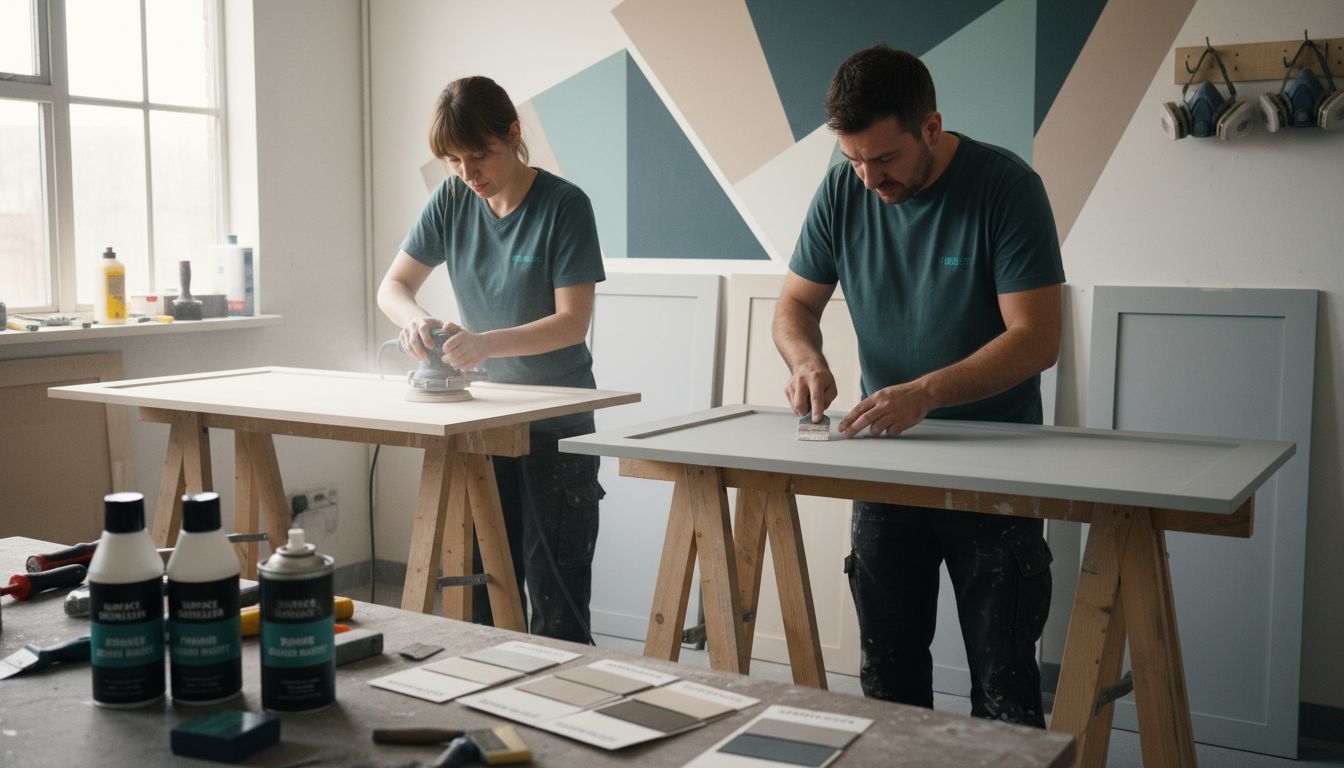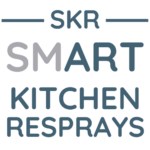Complete Guide to Why Respray Kitchen Doors
Over 70 percent of homeowners find themselves frustrated with outdated kitchen cabinets. A full kitchen renovation can drain your budget and disrupt your daily routine for weeks. Kitchen door respraying offers a smarter solution by refreshing your space at a fraction of the cost while still delivering a flawless, factory-fresh finish. Discover how this approach saves money, reduces waste, and instantly transforms the heart of your home.
Table of Contents
- What Kitchen Door Respraying Involves
- Popular Paint Types And Finish Options
- How The Respray Process Works Onsite
- Benefits Over Replacing Kitchen Doors
- Costs, Durability, And Common Mistakes
Key Takeaways
| Point | Details |
|---|---|
| Cost Efficiency | Kitchen door respraying is 70-80% cheaper than full door replacement, making it a budget-friendly improvement option. |
| Rapid Transformation | The entire respraying process typically takes 2-3 days, offering a quick refresh without extensive renovation disruptions. |
| Durability and Maintenance | Professionally applied resprays last 8-10 years, significantly outperforming DIY jobs, ensuring long-lasting results. |
| Customization Options | Homeowners benefit from unlimited color and finish choices, allowing personalized aesthetics to match their kitchen style. |
What Kitchen Door Respraying Involves
Kitchen door respraying is a transformative home improvement technique that breathes new life into your existing kitchen without the massive expense and disruption of a complete renovation. Instead of replacing doors entirely, this process involves professionally cleaning, preparing, and repainting kitchen cabinet doors to create a fresh, modern appearance.
The respraying process typically includes several critical stages that require precision and expertise:
- Surface Preparation: Thorough cleaning and degreasing of kitchen doors to remove years of accumulated grime, cooking residues, and potential contaminants
- Repair Work: Addressing minor surface imperfections like scratches, dents, or chips before painting
- Sanding: Creating a smooth, uniform surface that allows paint to adhere effectively
- Priming: Applying specialist primer designed for kitchen surfaces to ensure long-lasting paint adhesion

Professional kitchen resprayers use specialized equipment like high-quality spray guns that provide an ultra-smooth, factory-like finish impossible to achieve with traditional brushes or rollers. Kitchen Door Respraying Best Practices outlines how industrial-grade spray equipment ensures an even, streak-free coating that transforms your kitchen’s aesthetic.
Technically, the respraying process involves multiple layers of specialized paint application. Professionals typically apply 2-3 thin, even coats rather than one thick layer, which helps prevent drips, ensures better durability, and creates a more professional finish. The entire process can usually be completed within 2-3 days, depending on the number of doors and their current condition, offering a rapid transformation compared to full kitchen renovations.
Popular Paint Types and Finish Options
Kitchen door respraying offers an exciting range of paint types and finishes that can dramatically transform your kitchen’s aesthetic and functionality. The choice of paint and finish isn’t just about colour – it’s about durability, maintenance, and the overall look you want to achieve in your cooking space.
The most popular paint types for kitchen door respraying include:
Here’s a comparison of popular kitchen respray paint types and their key characteristics:
| Paint Type | Durability | Finish Effect | Suitable For |
|---|---|---|---|
| Acrylic Latex | High | Smooth, subtle sheen | High-traffic areas |
| Enamel | Very high | Hard, glossy | Busy family kitchens |
| Chalk | Moderate | Matte, trendy look | Vintage or rustic styles |
| Melamine | Exceptional | Smooth, factory finish | Laminate and hard surfaces |
- Acrylic Latex Paint: Offers excellent durability and easy cleaning, perfect for high-traffic kitchen areas
- Enamel Paint: Provides a hard, durable finish that resists chipping and wear
- Chalk Paint: Creates a trendy matte finish with excellent adhesion properties
- Melamine Paint: Specifically designed for laminate and hard surfaces, offering exceptional durability
Kitchen Paint Finish Guide for a Flawless Update highlights the importance of selecting the right finish for your specific kitchen environment. Different finishes offer unique characteristics:
- Gloss Finish: Extremely shiny, easy to clean, but shows imperfections more readily
- Semi-Gloss: Provides a subtle shine with good cleanability
- Satin Finish: Offers a soft, pearl-like sheen that hides minor surface imperfections
- Matte Finish: Creates a modern, sophisticated look but requires more careful maintenance
Professional kitchen resprayers typically recommend considering factors like natural light, kitchen size, and cooking habits when selecting a paint type and finish. A glossy finish might work brilliantly in a bright, spacious kitchen, while a matte finish could add depth and character to a smaller, more intimate cooking space. The right combination can not only refresh your kitchen’s appearance but also protect your doors from daily wear and tear.
How the Respray Process Works Onsite
The onsite kitchen door respraying process is a precise, multi-step approach that transforms your existing kitchen without the need for complete replacement. Professional resprayers follow a meticulous methodology designed to deliver exceptional results while minimizing disruption to your home environment.
The typical onsite respray process involves several critical stages:
- Initial Consultation and Preparation
- Comprehensive assessment of kitchen doors and surfaces
- Colour and finish selection discussion
- Detailed protection of surrounding kitchen areas
- Removal of hardware like handles and hinges
- Surface Preparation
- Thorough deep cleaning to remove grease, grime, and contaminants
- Careful sanding to create a smooth, uniform surface
- Repair of minor imperfections like scratches or dents
- Application of specialist primer for optimal paint adhesion
Kitchen Painting vs Kitchen Spraying Explained highlights the key differences between traditional painting and professional spraying techniques. Professional spray equipment allows for an ultra-precise, factory-like finish impossible to achieve with standard painting methods.
The actual spraying stage is where the magic happens. Technicians use industrial-grade spray guns that create an incredibly fine, even mist of paint, ensuring complete coverage without drips, runs, or uneven patches. Multiple thin layers are applied, allowing each coat to dry perfectly before the next, resulting in a smooth, durable finish that looks like it came straight from the manufacturer. The entire onsite process typically takes 2-3 days, depending on the kitchen’s size and complexity, offering a rapid transformation with minimal home disruption.
Benefits Over Replacing Kitchen Doors
Choosing kitchen door respraying over complete replacement offers homeowners a compelling alternative that delivers dramatic transformation while minimizing cost, disruption, and environmental impact. Unlike full door replacement, which can be an extensive and expensive process, respraying provides a smart, efficient solution to refresh your kitchen’s aesthetic.
The key advantages of respraying compared to replacing kitchen doors include:
- Cost Efficiency: Respraying typically costs 70-80% less than full door replacement
- Minimal Disruption: Complete process takes 2-3 days versus weeks for full kitchen renovation
- Environmentally Friendly: Reduces waste by repurposing existing doors
- Instant Transformation: Achieves a factory-fresh finish without structural changes
- Customization: Allows unlimited colour and finish options
Kitchen Respray for Home Value: Complete Guide demonstrates how respraying can significantly enhance property valuation with a fraction of replacement costs. Professional respraying maintains the original door structure while providing a completely renewed appearance, making it an intelligent investment for budget-conscious homeowners.
The long-term benefits extend beyond immediate aesthetics. Professionally resprayed doors receive industrial-grade paint application that offers superior durability compared to standard painting methods. This means your kitchen doors will resist chipping, scratching, and general wear more effectively than traditional approaches, ultimately providing a cost-effective solution that looks pristine for years to come. The precision of professional respraying ensures a finish that rivals brand new doors, without the hefty price tag or extensive renovation process.

Costs, Durability, and Common Mistakes
Understanding the financial investment, longevity, and potential pitfalls of kitchen door respraying is crucial for homeowners considering this transformative home improvement technique. The process involves more than just applying a fresh coat of paint – it requires precision, expertise, and careful planning to achieve outstanding results.
Cost Breakdown:
- Basic Respray: £500-£1,500 depending on kitchen size
- Premium Finish: £1,500-£3,000 for complex designs or larger kitchens
- Comparison to Replacement: 70-80% cheaper than full kitchen door replacement
The most common mistakes homeowners make during kitchen door respraying include:
- DIY Attempts Without Proper Preparation
- Skipping thorough surface cleaning
- Using incorrect primer or paint type
- Not protecting surrounding surfaces
- Rushing the preparation process
- Choosing Incorrect Paint or Finish
- Selecting low-quality paint unsuitable for kitchen environments
- Picking a finish that doesn’t match kitchen usage
- Ignoring durability requirements
Complete Guide to Why Refurbish Your Kitchen emphasizes that professional respraying delivers superior durability compared to amateur approaches. High-quality resprays typically last 8-10 years with proper maintenance, significantly outperforming DIY paint jobs that might deteriorate within 2-3 years.
Professional resprayers guarantee exceptional durability through meticulous surface preparation, industrial-grade equipment, and specialist paint application techniques. They understand that kitchen doors endure significant daily stress from moisture, heat, and constant handling. By addressing potential issues like surface imperfections, using correct primers, and applying multiple thin layers, professionals ensure a finish that not only looks pristine but also withstands years of intense kitchen environment challenges.
Refresh Your Kitchen Doors with Professional Respraying Today
If you are tired of faded, chipped or outdated kitchen doors but dread the cost and mess of a full replacement then professional kitchen door respraying is the perfect solution. This smart choice addresses key challenges like long renovation times, high expense and environmental waste by rejuvenating your kitchen doors in situ with industrial-grade paints and expert finish techniques. Discover how surface preparation, specialist primers and multiple paint layers can deliver a factory-fresh look that lasts for years.

Ready to transform your kitchen quickly and affordably with minimal disruption? Explore more insights in our Uncategorized Archives – WordPress and then book your expert kitchen respray visit through our main website. Don’t wait for chipped paint and tired doors to spoil your cooking space any longer. Act now to enjoy a beautifully refreshed kitchen that combines style with durability and value.
Frequently Asked Questions
What is kitchen door respraying?
Kitchen door respraying is a home improvement process that involves cleaning, preparing, and repainting existing kitchen cabinet doors to give them a fresh, modern appearance without the need for replacement.
How long does the kitchen door respraying process take?
The entire kitchen door respraying process typically takes 2-3 days, depending on the number of doors and their condition, making it a faster alternative to full kitchen renovations.
What are the benefits of respraying kitchen doors instead of replacing them?
Respraying kitchen doors is usually 70-80% cheaper than replacement, offers minimal disruption to your home, reduces waste, and allows for a wide range of customization in colour and finish.
How long can a professionally resprayed kitchen door last?
A professionally resprayed kitchen door can last 8-10 years with proper maintenance, significantly outlasting DIY paint jobs that may deteriorate within 2-3 years.
Recommended
- Kitchen Door Removal Process for a Seamless Renovation – WordPress
- Complete Guide to Kitchen Respray Best Practices – WordPress
- Kitchen Hygiene and Respray: Complete UK Guide – WordPress
- The Essential Guide to Paint in Kitchen Renovation – WordPress
- Maintenance Guide – Timber Windows & Wooden Doors – ATW
